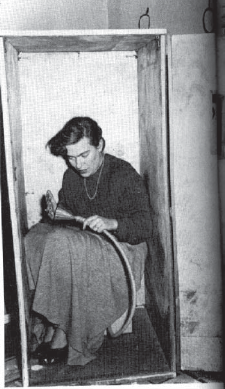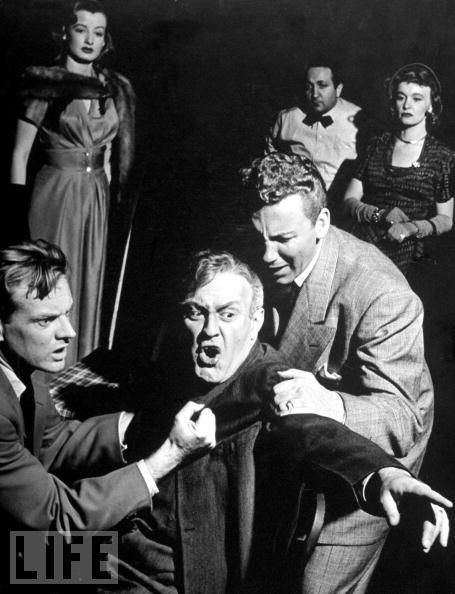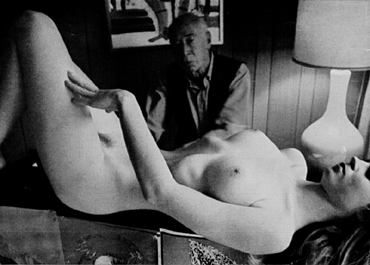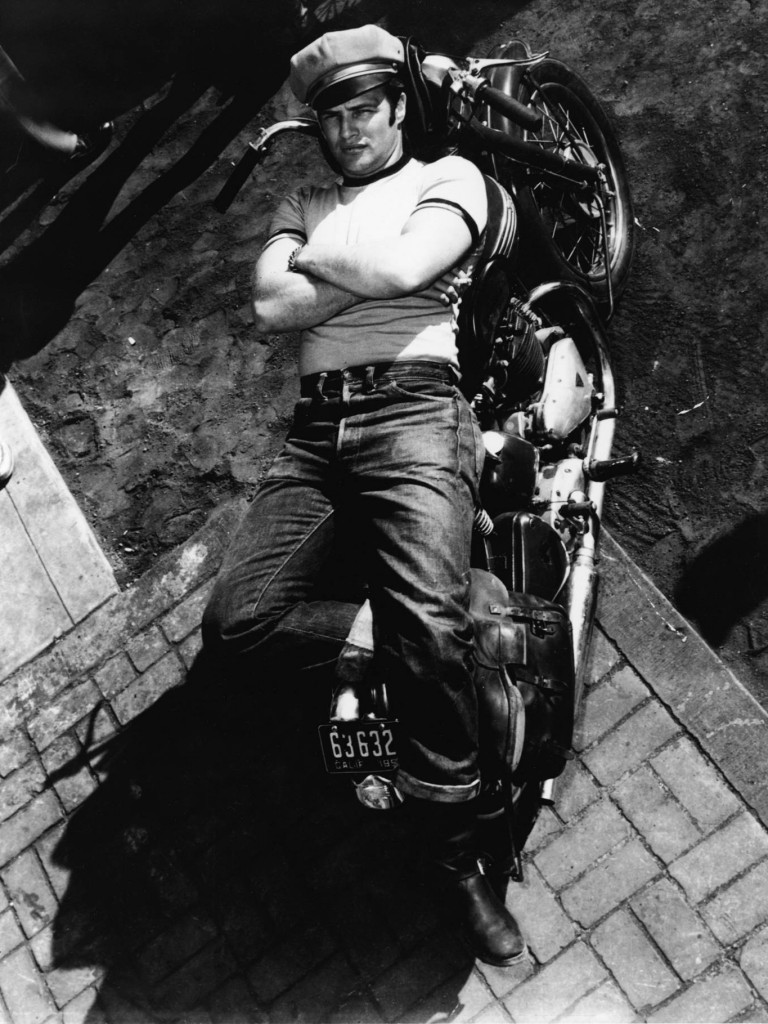“June 22 saw the publication of the second installment of Life and Loves Among the Beatniks. Allen Brown quotes freely from Norman Podhoretz and Herbert Gold. He describes the day of a typical beatnik as waking late in the morning in a single room apartment with little or no furniture, not bathing, shaving or brushing their teeth, simply picking random dirty clothes out of a pile of similar dirty clothes and heading out to The Bagel Shop to bum money for coffee. He concludes: ‘Most of all the beatnik wants to die. But next to death he loves to talk’.”

"A bit later Burroughs gave me a call. He said that he’d done some experiments with shooting through magazine pages mounted to panels, and he liked the results. Therefore, he had decided, he would like to shoot my painting after all. I was elated. And so it was on Easter Sunday of ‘87 that he phoned and said he was in the mood to go shooting, and invited me along. At his place we had to wait for Bill Rich to arrive. They had a shortage of shotgun shells, and, being Easter, there would be no place open to buy any. Therefore we stopped by the house of James Grauerholz..."
“And for just a moment I had reached the point of ecstasy that I always wanted to reach, which was the complete step across chronological time into timeless shadows, and wonderment in the bleakness of the mortal realm, and the sensation of death kicking at my heels to move on, with a phantom dogging its own heels, and myself hurrying to a plank where all the angels dove off and flew into the holy void of uncreated emptiness, the potent and inconceivable radiancies shining in bright Mind Essence, innumerable lotuslands falling open in the magic mothswarm of heaven.” ( Kerouac, On the Road )
Here Kerouac is explicitly celebrating the attractiveness of death, just as Ginsberg frequently writes of his desire to curl up in the soft comfort of the womb. The other side of complete acceptance, then, is complete rejection, withdrawal into the cool neutral realm of perfect passivity. Although it embodies a vague intellectuality, as a literary movement it was persistently anti-intellectual. “I don’t know I don’t care and it doesn’t make any difference,” Kerouac affirmed in his “philosophical final statement,” and the stammering hero of his second book, “The Subterraneans” bears him out: “Details are the life of it,” he shouts; “say everything on your mind, don’t hold it back, don,t analyze or anything as you go along.” Before this indiscriminate accumulation of details- the hallmark of this new writing- order, analysis, form and eventually coherence can be put under great pressure.

"The object of the (politically motivated) scientific community's opposition of Dr. Reich's work was his "orgone accumulator". The orgone accumulator, a "box" large enough for a person to sit in and constructed of alternating layers of organic and inorganic substances, was used to successfully treat his patients for various maladies. In his book Cancer Biopathy (1948), Dr. Reich recreates his carefully documented work regarding the treatment of several cancer patients deemed hopeless and terminal by orthodox medicine. Several of his cancer patients were "cured" but, being the careful man of science he was, Dr. Reich was careful not to declare orgone treatment as a cure for cancer. After a lengthy harassment campaign by the FDA over the medical use of orgone, that began in the mid 1940s, Dr. Reich died in prison in 1957."
The result is a style of writing that recalls the automatic writing school of André Breton, and the punchy jabbing of an Alfred Jarry.In contrast to the Beat generation, the Surrealist movement was revolutionary. Its aim was clearly defined, amalgamating Marx’s idea to “transformer le monde” with that of Arthur Rimbaud, to “changer la vie.” Its members were self admitted revolutionaries, under the leadership of the enigmatic André Breton. Through their methods of automatic writing, the analysis of dreams, and word games such as the “cadavre exquis” they sought the internal essence of mankind, the stripping of man down to his primitive levels of thought, shedding the sullied garments of a society marred by the corrupted values of capitalism.

Poster designed by Alfred Jarry. "When you consider it, Burroughs (the Father) might really be the Mark Twain of European Dada. His cultivated weirdness is singular. Alfred Jarry as much as Groucho Marx lurk in his routines. I think of his mad, high tea parlor games, his "Hangin' Judge" persona, his apocalyptic six-shooters blazing like radium tipped bullets at the Nova Gang. Think of his timeless fedora, his mummies -- stolen from Norman Mailer. But you might ask yourself, what can the famous cut-up technique say about the "Unspeakable vision of the individual?" In fact, in that "anyone can do it," doesn't the method remove the particular artist from the creative process to a significant degree? Doesn't it strip him of his singularity and produce a sort of meta-gibberish, or literary equivalent of Duchamp's ready mades?"
As Richard Gombin explores in his article on the emergence of French Leftism, the Surrealists were following a chronological pattern of French literature attacking the “monotonous world” and exerting an individualism which had been lost, or swallowed, by society. Starting with the romantics, and especially “les fleurs maladives” of Baudelaire, and following through the symbolist movement, where Rimbaud and the macabre Comte de Lautréamont stood out amongst the Surrealist’s heroes and forebears, before extending into the twentieth century and the nihilism of Dadaism.

"In l’Amour Fou Breton establishes a rhetoric between Marxist and Freudian thought and the concept of love held by himself and other Surrealists, presenting love, and sex in particular, as the main intuitive instinct of man which remains, and so is thus without boundaries; Quelque entorse qu’on cherche aujourd’hui à faire subir à la pensée Marxiste sur ce point comme sur tant d’autres, il est indéniable que les auteurs duManifeste Communisten’ont cessé de s’élever contre les espoirs de retours..."
“It may seem paradoxical that a group who would claim the greatest surrealist act as being to “descendre dans la rue, et à tirer au hasard, tant qu’on peut, dans la foule,” (and who hailed the young female assassin Germaine Berton as a heroine) as being a group dedicated to moral values, in the same way as the sexual and narcotic liberalness of the Beats didn’t fit in with traditional western values. But the acts of the Surrealists, and before them the Dadaists, were acts of principle, they were declaring that the whole of western society must be overturned, that one must return to ‘l’intérieure’ of mankind, to find the essential needs and values there, that western thought had been so corrupted that nihilist expression (
t destruction or creation) was the only possible way of expounding their message.”
"Actor Lee J. Cobb plays Willy Loman being restrained while babbling at imaginary characters in the Broadway production of "Death of a Salesman" in 1949. The play made Arthur Miller famous, and turned Willy Loman into a shorthand phrase for a deluded loser who dreams of success beyond himself."
With the Beats, the main theme founders and breaks down under a welter of subjective variations. Sometimes it works, sometimes… Its often compared to abstract expressionist painting, where words are flung on a page, less as an act of communication that as an act of aggression and it edgy hint of violence. It was an aesthetic that was upsettingly discontinuous and jerky that alternated between aggression and passivity.
It was no accident that many of them were followers of Wilhelm Reich, a maverick psychiatrist who treated patients by placing them in the “orgone box” he had invented. Reich himself alternated between flashes of brilliance between long stretches of junk pseudo science. his box could almost be considered as one of the monuments of their movement; for in it, cultural withdrawal is complete, will and intelligence are suspended, and the emotions are at the mercy of mysterious “cosmic” stimuli.
…In 1940 Reich spent five hours with Einstein. When Reich left, he said to Einstein, “You understand now why everyone thinks I’m mad.” Einstein replied: “And how.”… Reich wrote Listen, Little Man! in 1946 and it was published in 1948. The book is Reich’s warning to the common man in all societies that he, the little, average man, is lethally responsible for the rapidly spreading social cancer of fascism. Reich had seen how common citizens in Germany embraced their enslavement by their Nazi overlords. He was now seeing the reappearance of the same phenomenon in the United States and Europe. Someone needed to tell the average citizen that his personal characteristics were at the root of the world-wide plague of totalitarianism….
It is significant that the heroes and saints of the Beat Generation are almost exclusively death lovers and escapists. The junkies, the derelicts, the delinquents, the madmen, the criminals, and the Outsiders who peopled this literature have in common their paralysis in the face of almost all intelligible, or at least conventional forms of behavior. Again, a great debt is owed to Henry Miller and his Tropic of Cancer published in 1934 in France and banned in the United States; the same combination of fiction and autobiography, within a context of stream of consciousness reflections; writing in the first person with fluctuations between past and present tense.

"But Marlon Brando stirred up the primordial stew of unrest and youthful angst of the pre rock’n’roll 1950’s, straddling his own Triumph as Johnny Strabler, the leader of the Wild Rebels motorcycle gang that terrorises the small American Midwestern town of Wrightsville in The Wild One in 1953. Unable to control the situation when a rival gang, headed by Lee Marvin (on a Harley) arrives and violence erupts, the exasperated sheriff pleads with Johnny, asking, “What are you rebelling against?” “Whaddya got?” was the response. The film was considered so potentially corrupting and inappropriate for a youth audience, that it was banned in Britain until 1968 and never shown in many American towns for fear of corrupting their fragile youth."
In many respects, the Beats were counterparts of the personification created on the level of popular culture by Marlon Brando. In “The Wild One” for example, Brando played a “saintly motorcyclist” , equipped with leather jacket, studded belt, and violent nature of the type that Ginsberg and Kerouac tended to embellish in their writing. Dean Moriarity, one of the central characters of “On the Road” , and also the secret hero of Ginsberg’s poem “Howl”, is to confused to speak clearly , but he expresses himself by stealing cars, taking drugs and conning his friends. Moriarity’s adolescent irresponsibility has in it something so poignant that Kerouac hailed him as a “new kind of American saint.”

William Burroughs in front of the Beat Hotel, Paris. "The approach I've taken is captured by Barry Miles' description of the Beat Hotel in Paris: "The cheap rent and permissive atmosphere fostered a climate of freedom and creativity unfettered by financial concerns. As non-French speakers, they had no involvement with French culture and the issues of the day, nor were they restricted by rules with which the French lived, simply because they were ignorant of them. As Jean-Jacques Lebel put it, 'They were on an island, isolated in this magic little paradise full of rats and bad smells. But it was paradisical because it gave them the green light to be themselves without having to confront America.' The Beat Hotel offered the freedom to be idle or to work with passionate intensity, to while away the day in cafés or to talk through the night."
The success of Brando’s imitators: James Dean, Ralph Meeker, Ben Gazzara, Paul Newman, Rod Steiger, and countless others; testified to the persistent popularity of a hero unlike any before seen in the movies. Like the heroes of the Beat literature, they were usually extremely withdrawn, but his subjectivity seemed as much the result of the actor’s technique as of the scenarist’s concept; an influence of the Russian director Stanislavsky, which exalted the actor,s personality over the written word. That is, the actor imposes his experience on the part rather than subordinating himself to it.
The personality of many Method actors, however, rather than being an individual expression, was often a parody of Brando playing Stanley Kowalski. The result of this imitation was a cultural hero with easily distinguishable traits which enhanced a rigid stereotype. The hero’s link with the Beat Generation was signified by the fact that he is invariably an outcast or a rebel who stands in the very uneasy relationship with society. His rebellion, in the popular culture, as much through clothing as through his behavior; a shabby careless appearance being an open sign of alienation who rebellion appears to be unmotivated, without political or social relevance , and the total, obscured by an inability to describe it.
He was the “Rebel Without a Cause” , whose sense of grievance has turned inward on himself, making his grip on reality extremely uncertain and tenuous. Although he often travels in groups, in gangs, he seems to be alienated even from his friends. He is a man whom nobody understands and who understands nobody. Toward the world of authority; his father, his teachers, and the police; he feels hostile and seems to be submissive only to his girlfriend. His confusion has isolated him within a self which he cannot comprehend and which, in consequence, causes him unspeakable gain.
In this character, the inarticulate hero appears in many movies covering the Beat period, and that despite surface differences never seems to change in essential parts. A generic Hollywood archetype. More timorous than literature and subject to rigid production codes, these movies do not glorify the heros delinquency, but they did their best to exploit it; violent nature is allowed expression , but is channeled against the heavies , which helps mosey the hero onto the path of the Lord.
“Though much has been written about the Beat generation, its effect on the counterculture of the 1960s has often become a point of dissension. Recently, two works on the Beat generation gave radically different views as to what extent the Beat generation were countercultural. Jennie Skerl, in her Reconstructing the Beats, expounds the more traditional view, placing the Beats as non-conformists and countercultural rebels, whereas a work by Manuel Luis Martinez, Countering the Counterculture: Rereading Postwar American Dissent from Jack Kerouac to Tomas Rivera, puts the Beat culture as a “rehashing of an American ‘rugged individualism’ that was ultimately hostile to a Rousseauean commitment to civic participation and radical egalitarian democracy” and even levels accusations of sexism and racism at the Beats, and that there was nothing inherently countercultural about them.
The problem with looking at the Beat movement in a countercultural light is that it immediately draws comparisons with the 1960s. The Beat generation was based on personal discovery, of subjective liberation, it was not a call to revolution, it was not an organized social movement. From the point of view of the 60s counterculture the role of the Beats was to create an awareness of the sadness and of the missing values within society. The counterculture then, was the mobilization of this restless youth coming of age at the beginning of the new decade. Although one leads to the other it is misleading to try to approach the two in the same terms.”







 COMMENTS
COMMENTS